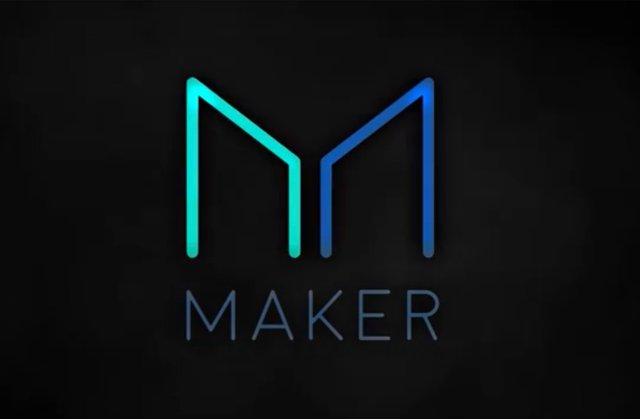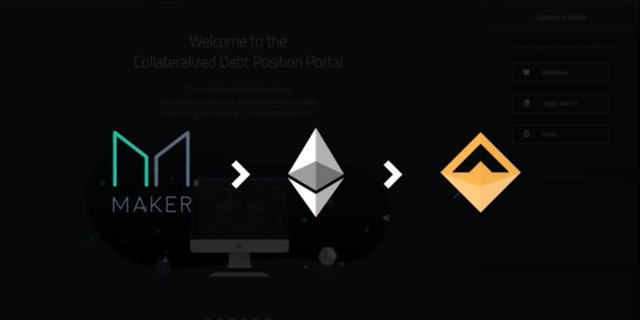MakerDao Platform a Decentralized Finance Credit Debt Facility explained.
Who is the MakerDao?

MakerDAO is a decentralized autonomous organization based platform that contains the maker coin (MKR) which acts as a governance coin, and the DAI which is a stable digital currency. The project was started in 2015 and did not conduct an ICO, instead choosing to privately sell MKR tokens to fund development over time. Maker’s DAI stable coin launched at the start of 2018
What is the MakerDao?
MakerDAO is basically a credit facility that issues loans with a certain interest rate called the stability fee against a collateral called Ethereum. The loans are paid to borrowers in Dai. The MakerDao issues new Dai to find each loan. It is like a country printing currency yo pay its debts. Each Dai is worth one dollar USD. The stability fee or interest rate is raised to reduce selling pressure on the Dai and help keep it pegged to the dollar and vice versa. The DAI stability fee or interest rates for borrowers was 1%, but later the stability fee increased from 1% to 3.5%.
Who Controls the System?
The holders of the MakerDAO Token MKR token influence certain aspects of the protocol such as: What should the be the annual borrowing fee be (stability fee)?, How much collateral should be backing each CDP? (collateralization ratio) and Shutting down the protocol in the case of a sudden drop in the price of Ether or another situation (emergency shutdown)?
What does the MakerDao do and why are there so many transactions?
The MakerDao provides loans in Dai, against assets, mainly Ethereum and in some instances Bitcoin held by Bitgo.
Let’s pause and define some terms and introduce some concepts.
Terms
Bank , a business that makes money providing credit.
Credit, means credit cards and loans like those used to buy cars and homes.
Interest, the fee or money you pay the bank for borrowing money in the form of credit cards or loans.
Stability fee is the same as interest.
Default, you are in default if you don’t pay your credit card bill or loan payments for two or more months. Aldo if the value of your asset falls below a predetermined value.
Default fee: extra money you pay the bank on top of your loan balance if you default.
Liquidate: if you default on your loan used to buy your car or home the bank takes your car or house and sells it to pay off your loan.
Liquidation fee is the same as a default fee.
Debt: money you owe the bank for credit card balances or loans.
Credit Facility is another name for a bank on a blockchain like the MakerDao or DJED.
Collateralized Debt product is another name for a loan granted you in exchange for the title or ownership papers of your collateral.
Collateral, an asset like a car, home or cryptocurrency, whose ownership papers are held by a bank or credit facility when you borrow money and use the asset as security for the loan.
Agree with liquidation. If you offer an asset as security for a loan, you agree the bank or credit facility can sell your asset if you default on your loan or the value of your collateral falls below a certain dollar value.
Ownership papers: For a car it’s the title and for cryptocurrency it’s your keys.
Concepts
Fractional Banking is a banking strategy which allows banks to loan out more money then they have in deposits, multiplying their profits, because they are only required to have 10% of their outstanding loan balances backed by capitol.
Example of Fractional Banking practice.
Adam deposits $1000 in his savings account at the bank, at 1% per year or $10.
The bank is only required to keep 10% of deposits on hand. It can loan out the rest.
The Bank loans $900 of Adams money to Bob, at 10% per year or 90$ pay for 10$ cost. Bob deposits the $900 dollars in his account at the same bank.
The Bank is only required to keep 10% or $90 in Bob’s account, $900-$90=$810.
The Bank loans $810 dollars of Bobs money to Charlie at 10%, that’s $81 per year.
Charlie deposits his $810 in his account.
The Bank is only required to keep 10% so $81, $810-$81=$729
The Bank loans Daniel $729.00 at 10% or $72.9 profit per year.
Daniel deposits his $729 in his account at the bank.
The bank keeps 10% or $72.9 in his account, $729-$72.9=$656.1
The Bank loans $656.1 to Eric at 10% and makes $65.61.
Eric deposits $656.1 in his account
The cycle continues.
The Bank got Adam to deposit his money for 1% interest.
The bank turned around and loaned 90% to Bob for $90, 9 times as much as they paid Adam and a $80 dollar profit. But it didn’t stop there; The bank made $81 dollars from Charlie, $72.90 from Daniel, $65.61 from Eric and this cycle repeats it self until there’s no more money to lend from Adams account. This is a simplification of Fractional banking. But it illustrates how the bank can make multiple loans and have multiple streams of income from Adams deposit, for which they pay him very little 1%, while charging 10% to loan out his money.
Loans are a Debt
Loans are a Product created by a bank or a credit debt facilities.
Loans are secured or Collateralized.
In the Decentralized Finance World, Loans are called “Collateralized Loan Products“ and also called
“Collateralized Debt Products”.
Collateralized Debt Products are also called by their abbreviation “CDPs”.
Loan to Value Ratio
Traditionally, a bank doesn’t loan you 100% of the value of an asset. It loans you a percentage. If the bank loans you 50% of the assets value, the loan to value ratio is 50%.
Collateralization Ratio
Credit Debt Facilities don’t use a loan to value ratio, they use something called a Collateralization Ratio. It is the inverse or opposite of a loan to value ratio.
In a loan to value ratio you create a fraction with the loan value on top (numerator) and asset value on the bottom. (denominator).
In a Collateralization ratio the value of the asset is on top, and the loan is on the bottom. If the asset is worth two dollars and the loan one dollar the collateralization ratio is 2:1 or 200%.
Liquidation
If you don’t pay your loan, the bank sells your asset, the car or your home you pledged as security or collateral and sells it to get back the money it loaned you. This process is called repossession in America in the case of a car or foreclosure in America the case of your home. In the world of decentralized finance the bank or “credit debt facility” will also liquidate your assets if your collateralization ratio drops below a pre-agreed upon number.
Vault: the name for your account at a “credit debt facility” or Bank on the blockchain.
Competitive suction.
If you default on your collateralized debt product, the credit debt facility will sell your asset. To lessen the downward selling pressure on the value of the asset, the asset is not sold on an exchange. Instead it’s sold in an auction where people make bids and the highest bid wins.
Over capitalization of CDP: the value of your asset in the vault collateralizing your loan or CDP is above the collateralization ratio number which triggers liquidation of your assets. This is a good.
Under capitalization of CDP, this is the opposite of over capitalization, as the value of your asset means your collateralization ratio is “at or below” the number which triggers liquidation of your assets. This is bad.
Decentralized finance profit motive for CDP or collateralized debt products.
Investors take out loans on cryptocurrency they are holding long term so they can earn money from the appreciation of the cryptocurrency asset and use the loan funds to invest in another asset that generates an additional return on capitol. This means multiple streams of income from the original capitol investment and an increased return on investment.
Tokenization: the representation of a physical asset Ads digital token.
Fractional ownership.
After a physical asset is tokenized investors can buy very small portions of an investment and these small ownership portions are called fractions.
The Profit Motive on the MakerDao
It is driven by securitization, Tokenization, fractional lending and arbitrage.
For Example**
If you deposit one Ethereum worth $150 USD in the MakerDao you can ask for a 50 Dai loan and 50 Dai is worth 50 dollars USD. Your asset, the Ethereum, is held as collateral and you get it back when you repay the loan. This process of depositing your Ethereum as collateral and getting a loan is known as collateralization.
The ratio of collateral to loan is $150/$50 or 3:1. This is called your collateralization ratio. The minimum ratio is 1.5. If the price of Ethereum falls, your ratio will fall. Once the dollar value ration of your Ethereum collateral gets to 1.5 your Ethereum collateral will be liquidated or sold to pay back your loan.
Why Collateralize your Ethereum
As an investor your rate of return on Ethereum is variable, for example if the price for Ethereum increased 5% in one month your ROI was 5%.
If you owned $100 worth of Ethereum your 5% ROI was worth $5 USD. But what if you owned 10 times as much Ethereum? $1000 worth of Ethereum at a 5% ROI would mean $50 USD.
If you had 100 times as much Ethereum your 5% ROI would be worth $500 USD. So to make more money, you need to buy more Ethereum. But with collateralization you can buy more Ethereum without having more money.
For Example.
You buy and hodle one Ethereum worth $150 USD. In one month if your ROI was 5%.
150/100 =1.5 x5 = $7.5 USD
But if You deposit your $150 worth of Ethereum in the MakerDao, you can borrow 75 Dai, using your $150 worth of Ethereum as collateral. You then exchange 75 Dai for $75 USD on the exchange and buy $75 dollars worth of additional Ethereum. Now you own $225 dollars worth of Ethereum. So if in one month you get a 5% ROI on $225 USD or 225/100=2.25x5=11.25$.
So by using the MakerDao you were able to increase the amount of Ethereum your hodling from $150 to $225, a 50% increase, but without investing any additional capitol. While you pay 3.5% interest on the additional $75 worth of Ethereum you still get 1.5% ROI without increasing your capitol invested.
Discussion
You didn’t use any additional capitol to increase your ROI, you used a “Credit Facility”, which is called MakerDao. This allowed you to earn money from the appreciation of your asset and to borrow against your asset to buy more asset and earn more money. That’s why this is popular and that’s why the MakerDao has increasing volumes as more people collateralize their assets to make more money.
In some ways, this is a win-win situation as the MakerDao gains 3.5% stabilization fee and the borrower gains addition ROI.
But there’s more.
Bitgo is currently offering a service which allows people to Tokenize their Bitcoin and get Ethereum. Then those Bitcoin owners can deposit their “Ethereum loans” at the MakerDao and borrow against it. Then they can earn off the appreciation of Ethereum and the appreciation of their Bitcoin.
And even more
You can also deposit the Ethereum you bought with your MakerDao loan in the MakerDao to increase both the amount deposited and the amount you can borrow. So if you deposited $300 worth of Ethereum and borrowed $100 in Dai, which you changed to dollars and bought Ethereum. You could deposit this additional $100 worth of Ethereum in the MakerDao for a total of $400 dollars worth of Ethereum in your account. Now you could borrow an additional $100 to bring your total borrowing to $200 and use this second $100 loan to buy $100 worth of Ethereum and deposit this also, for a total of $500 of Ethereum deposited and $200 borrowed.
Now your $300 worth of Ethereum has grown to $500 worth of Ethereum using the MskerDao credit facility and your collateralization ration is 500/200 or 2.5, well above the 1.5 liquidation market and requiring a 40% drop in the Ethereum Price
Are losses possible?
Certainly. But they are very similar to your possible losses HODLing Ethereum.
Example
You buy and hodle $150 worth of Ethereum. In one month it drops 50%. Now the value of your $150 has fallen to $75. You lost 50%. If you sell now, you get $75.00.
If you take the same $150 USD investment, deposit it in the MakerDao and borrow 75$ ( 75 Dai, exchange for $75 dollars, but $75 dollars worth of Ethereum and now hodle 225$ worth of Ethereum for one month. If Ethereum falls in value 50%, your Ethereum collateral deposited in the MakerDao will be liquidated or sold for 75 dollars to pay back your loan. You are left with the $75.00 worth of Ethereum you bought using the loan. Basically the same position you would have been in, if you had just hodled your original $150 worth of Ethereum.
So technically there are losses, but in reality your ROI is zero in both scenarios.
Decentralized Finance
The MakerDao doesn’t care about your race, religion, sex or country of origin. There are no financial qualifications other then having Ethereum. This is permission-less, as in you don’t need anyone’s permission to do this. It is also trust-less by design as the smart contract locks up your Ethereum when you enter the agreement and releases your Ethereum when you repay the loan.
This is the #Makerdao, this is #Decentralized #Finance, this is where #Finance meets #Technology and creates something new called #FinTech...this is the future where finance and technology are won.
@shortsegments
If you came here from my wrapped Bitcoin/ether post to read this first, you can go back there by clicking this Link



@tipu curate 2
Downvoting a post can decrease pending rewards and make it less visible. Common reasons:
Submit
Upvoted 👌 (Mana: 2/6) Passive income || Compare APR
Downvoting a post can decrease pending rewards and make it less visible. Common reasons:
Submit
thank you for your support of my blog!
Downvoting a post can decrease pending rewards and make it less visible. Common reasons:
Submit